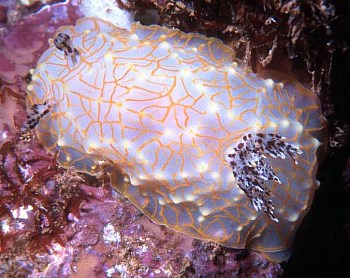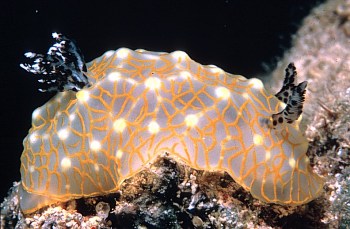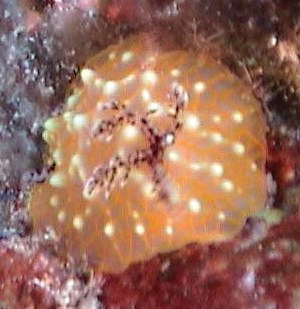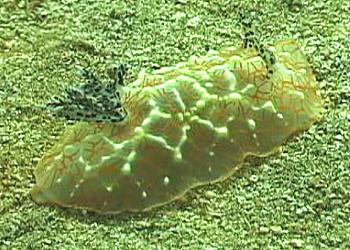

Halgerda terramtuentis
Bertsch & Johnson, 1982
Order: NUDIBRANCHIA
Suborder: DORIDINA
Superfamily: EUDORIDOIDEA
Family: Dorididae
DISTRIBUTION
Known only from the Hawaiian Islands.
PHOTO
Hawaii. Photos: Scott Johnson.
This is one of a group of white species of Halgerda with orange markings. This species is characterised by relatively low white-tipped tubercles, a network of solid gold-orange lines on the dorsum between the tubercles, and a submarginal gold-orange line around the mantle edge. Known only from Hawaii.
There are three species of Halgerda with a network of orange lines. In H. malesso the network of lines sometimes fuse to form orange patches in the depressions, there are multiple fine orange lines around the mantle edge, and the fairly high tubercles are capped with orange. In Halgerda batangas, which also has a network of orange lines, the ridges and tubercles are low and rounded. The tubercles are capped with orange-red with a basal ring of white. The edge of the mantle is white with orange-red tubercles. The foot is edged with orange. In Halgerda terramtuentis the lines are golden orange, the tubercles are capped with white and there is a single submarginal orange line around the mantle edge..
Other similar coloured species include Halgerda carlsoni and Halgerda aurantiomaculata.
References:
• Bertsch, H. & Johnson, S. (1982) Three new species of dorid nudibranchs (Gastropoda: Opisthobranchia) from the Hawaiian Islands. The Veliger, 24(3): 208-218.
• Carlson, C.H. & Hoff, P.J. (1993) Three new Halgerda species (Doridoidea: Nudibranchia: Opisthobranchia) from Guam. The Veliger, 36(1): 16-26.
• Carlson, C.H. & Hoff, P.J. (2000) Three new Pacific species of Halgerda Opisthobranchia: Nudibranchia: Doridoidea). The Veliger, 43(2): 154-163.
Rudman, W.B., 2000 (June 26) Halgerda terramtuentis Bertsch & Johnson, 1982 . [In] Sea Slug Forum. Australian Museum, Sydney. Available from http://www.seaslugforum.net/find/halgterr
Related messages
Re: Halgerda terramtuentis from Fiji?
December 8, 2002
From: Bradley Bowen
Dear Bill:
Thanks for replying to my message. Sorry for the delay in responding but I've been diving on the Komodo Dancer in Indonesia for the past week and just returned home. I checked my dive log and must apologize for the locality error. The nudibranch photograph was taken on May 14, 2002 at a dive site on the Kona Hawaii Coast named "Stoney Plateaus" by the Kona Aggressor, not Fiji.
I did get a number of interesting nudibranch photographs from the Satonda Island to Komodo Island areas from my last trip, and will forward some of them in the future. One of the species is quite bizzare looking.
Bradley Wm. Bowen
bbowen@strongandhanni.com
Bowen, B.W., 2002 (Dec 8) Re: Halgerda terramtuentis from Fiji?. [Message in] Sea Slug Forum. Australian Museum, Sydney. Available from http://www.seaslugforum.net/find/8622Dear Bradley,
Thanks for correcting the locality data. It would have remained a puzzling record. I look forward to seeing some of your Indonesian finds
Best wishes,
Bill Rudman
Halgerda terramtuentis from Fiji?
November 28, 2002
From: Bradley Wm. Bowen

This nudibranch was observed in Fiji in December 2001. The topography was a coral reef with little sand. We were only 80 feet from shore and there was strong surge of around 4-5 feet, that increase to 8-10 feet as you approached the shore. Depth was roughly 55 feet. Nudibranch was on a large coral bolder on the margin of deep water.
Please respond and provide any information possible.
Thanks!
Bradley Wm. Bowen
bbowen@strongandhanni.com
Bowen, B., 2002 (Nov 28) Halgerda terramtuentis from Fiji?. [Message in] Sea Slug Forum. Australian Museum, Sydney. Available from http://www.seaslugforum.net/find/8482Correction: This animal was actually photographed May 14, 2002 at a dive site on the Kona Hawaii Coast named "Stoney Plateaus". See Bradley's message.
Dear Bradley,
I should have got Scott Johnson to answer this as well as your earlier message, as this slug is
Halgerda terramtuentis, which was named by Scott and Hans Bertsch. Up until now it was known only from the Hawaiian Islands. Is there any possibility the locality on your photo may have got mixed up, as Fiji is quite a range extension for this species.
Best wishes,
Bill Rudman
Halgerda terramtuentis from Hawaii
January 21, 2001
From: Marco Tassara

Please help identify this nudibranch. It was seen off hawaii at 30' in depth. Enclosed is the picture.
Marco
marco_tassara@yahoo.com
Tassara, M., 2001 (Jan 21) Halgerda terramtuentis from Hawaii. [Message in] Sea Slug Forum. Australian Museum, Sydney. Available from http://www.seaslugforum.net/find/3526Dear Marco,
This is Halgerda terramtuentis which seems to be endemic to Hawaii. I am not sure if you are familiar with how the Forum works but you will find some more information on the species at the top of this page, and other messages about it below your message.
Best wishes,
Bill Rudman
Halgerda terramtuentis from Hawaii
June 27, 2000
From: Scott Johnson


Hi Bill,
Here are some shots of the Hawaiian Halgerda terramtuentis. It is one of the more commonly observed nudibranchs in Hawaii; although you tend not to see large numbers at any one time, it lives in a pretty wide variety of primarily subtidal habitats and is usually well exposed to view both day and night. While it can be cryptic in multicolored sponge-encrusted ledges, it can also contrast with its surroundings in some areas.
Scott
johnson@kmr.ll.mit.edu
Johnson, S., 2000 (Jun 27) Halgerda terramtuentis from Hawaii. [Message in] Sea Slug Forum. Australian Museum, Sydney. Available from http://www.seaslugforum.net/find/2625Thanks Scott,
Bill Rudman.
